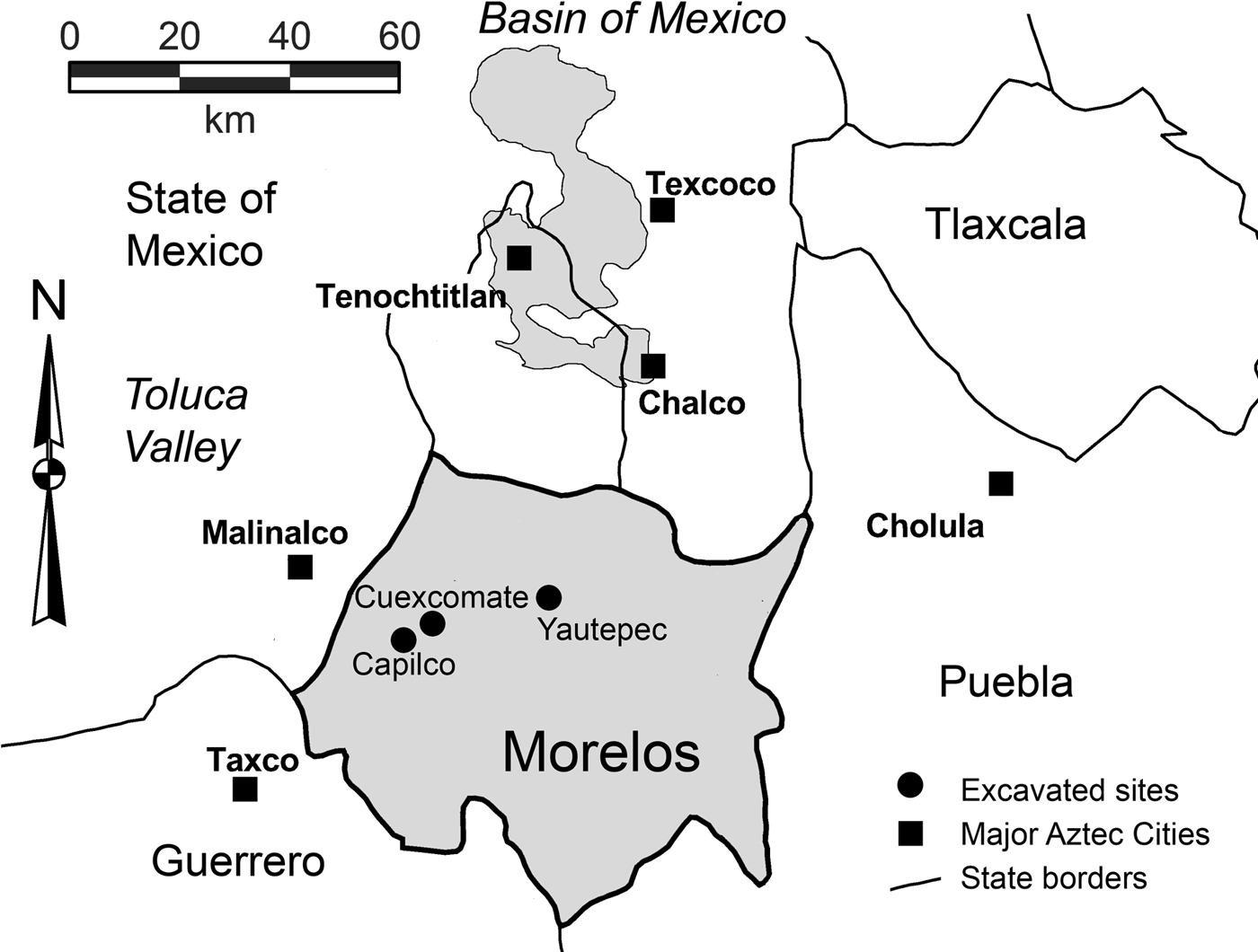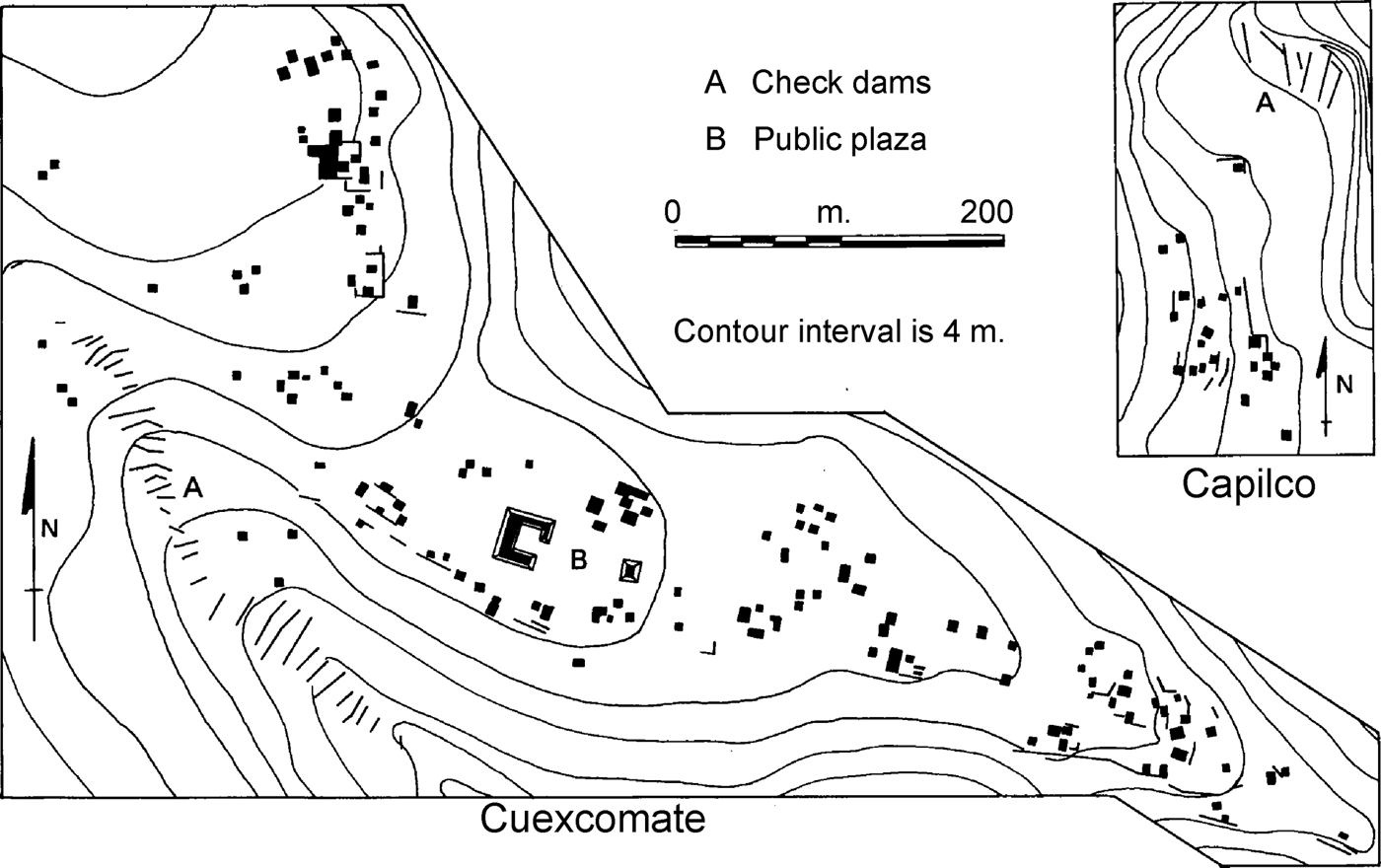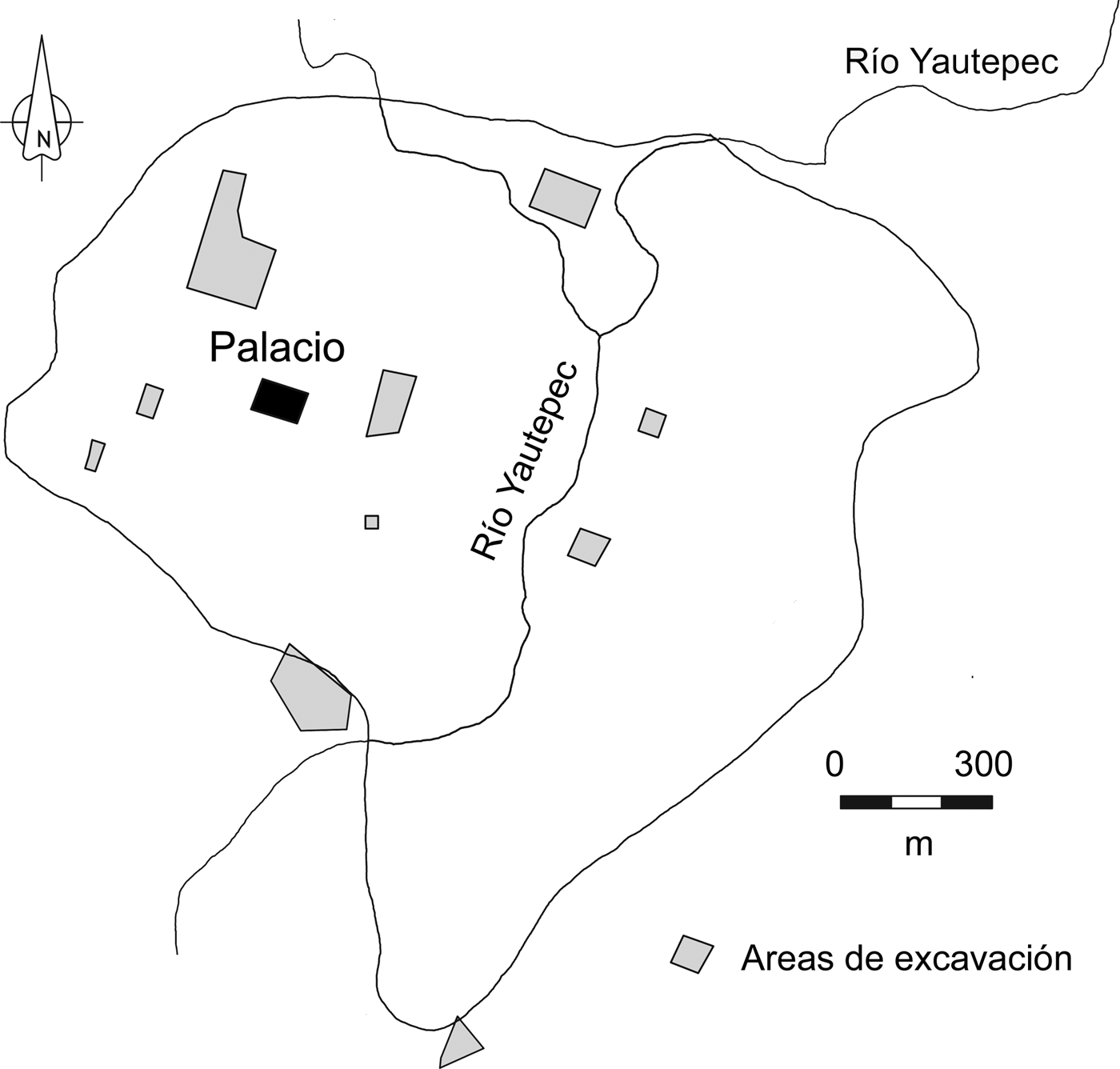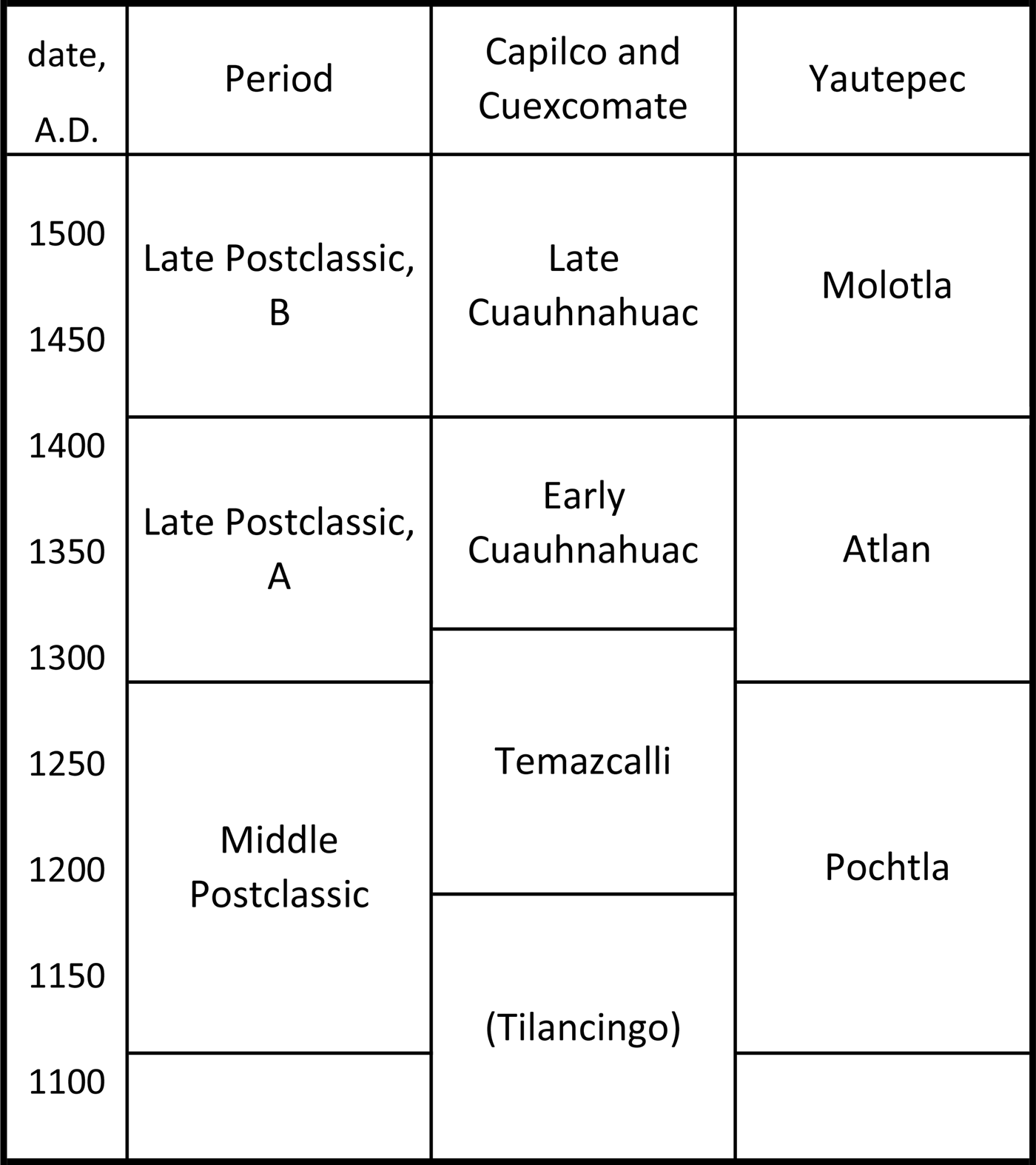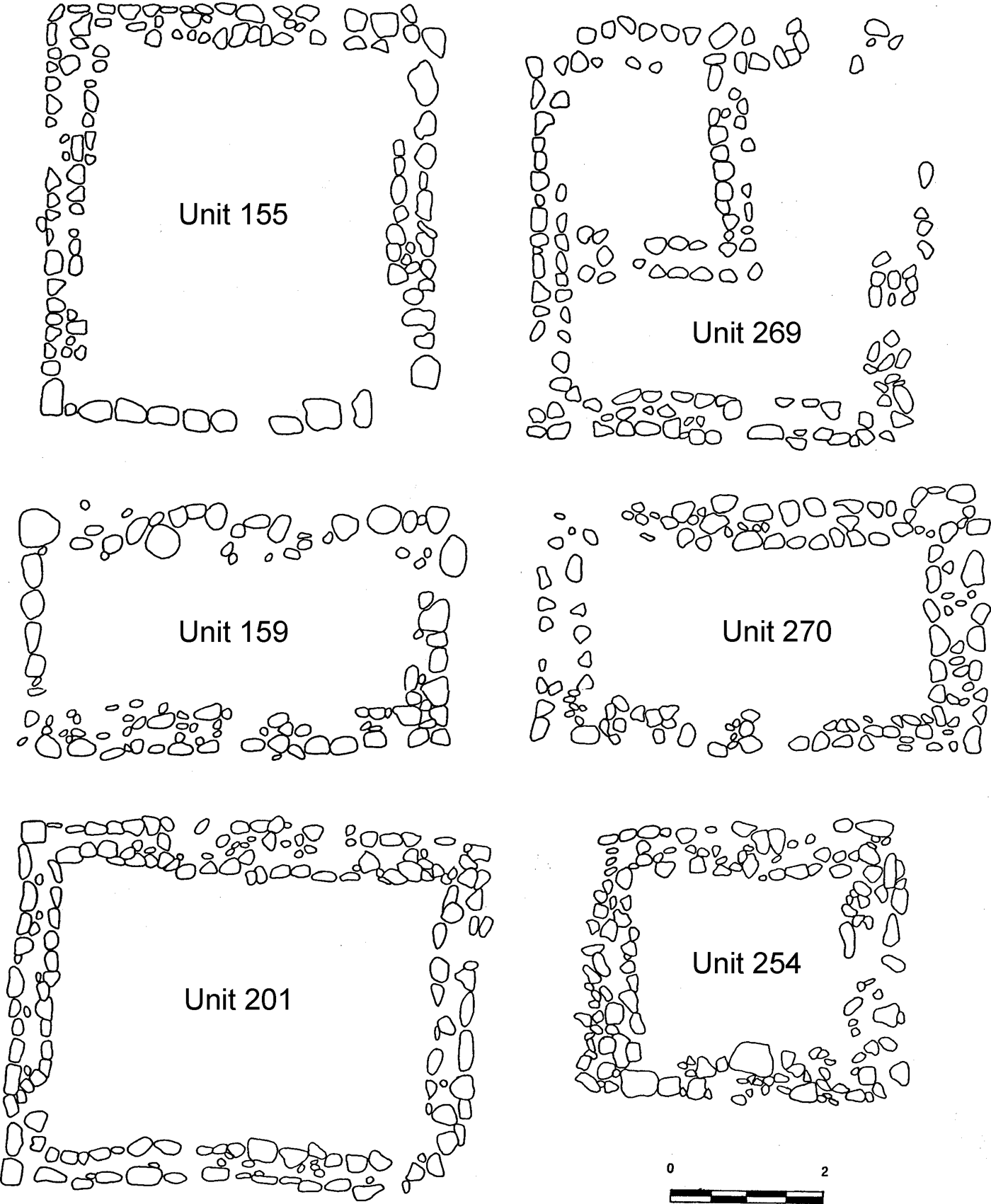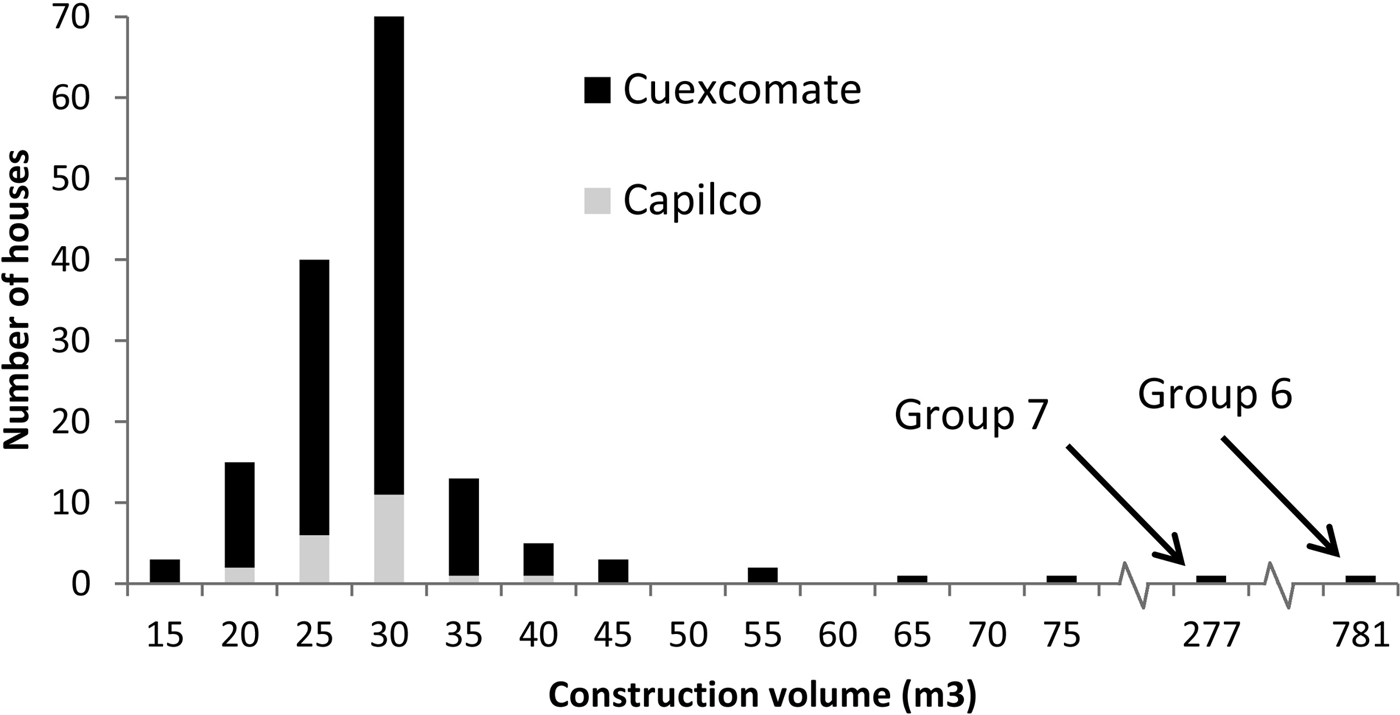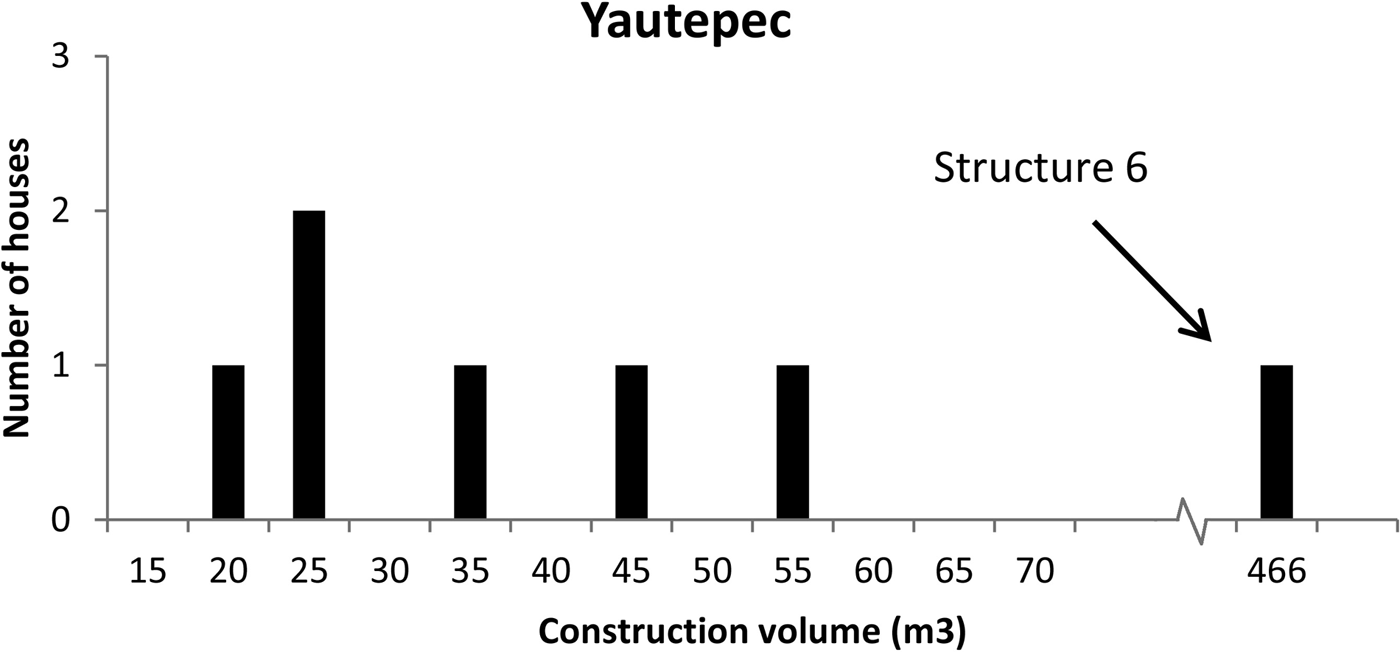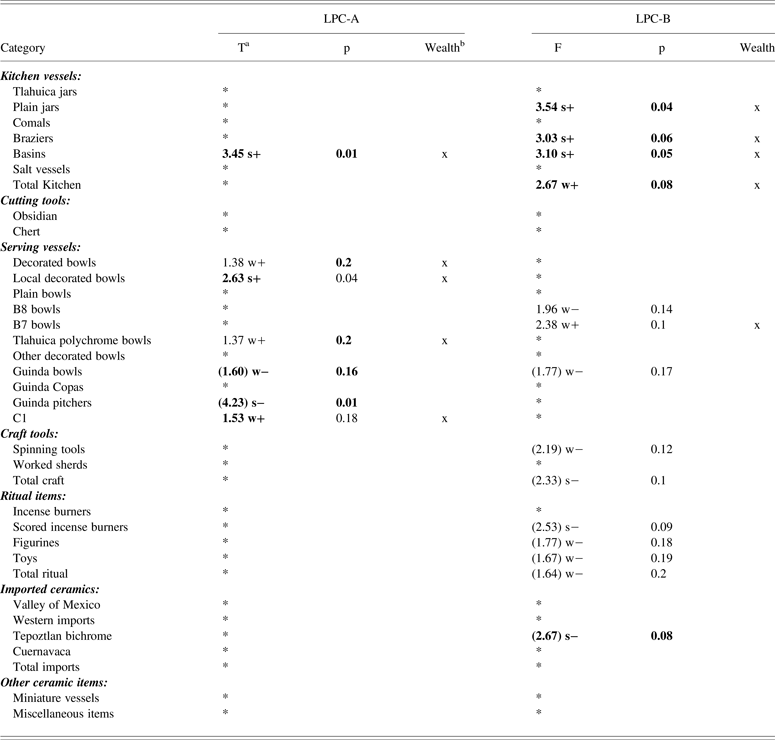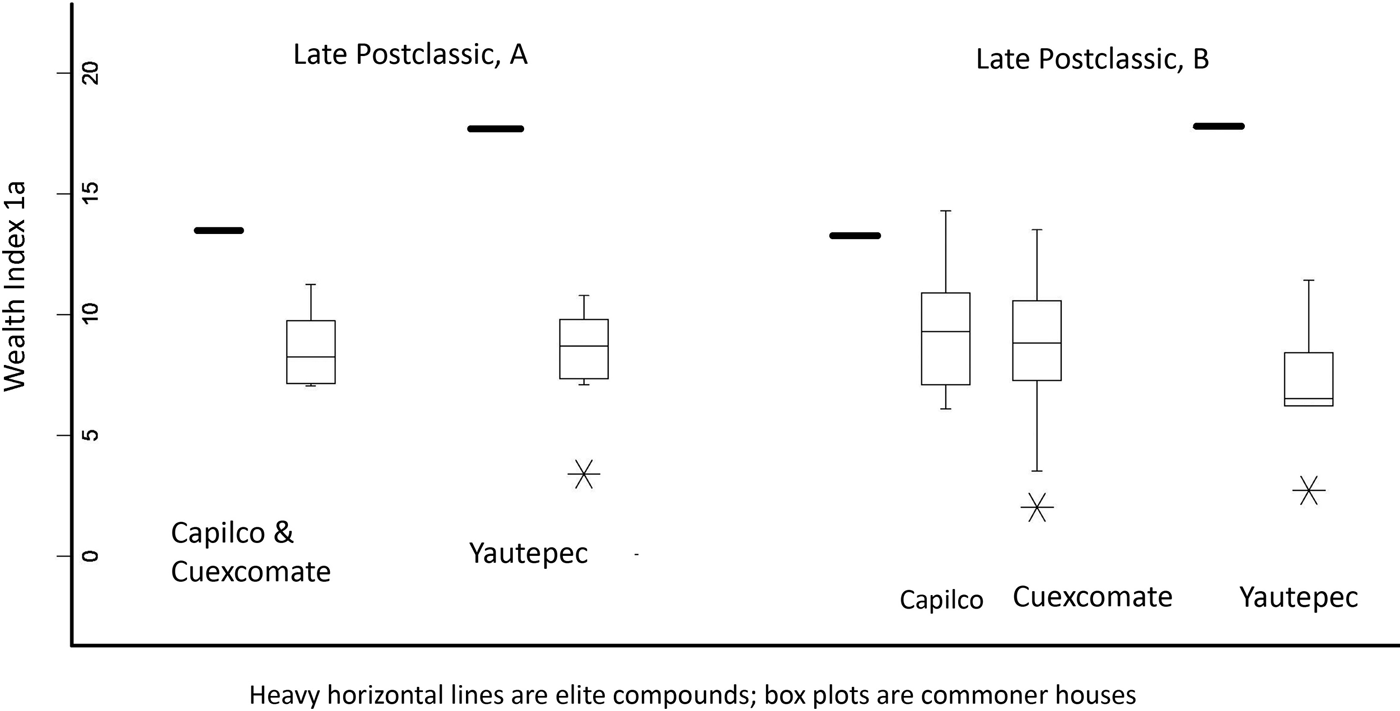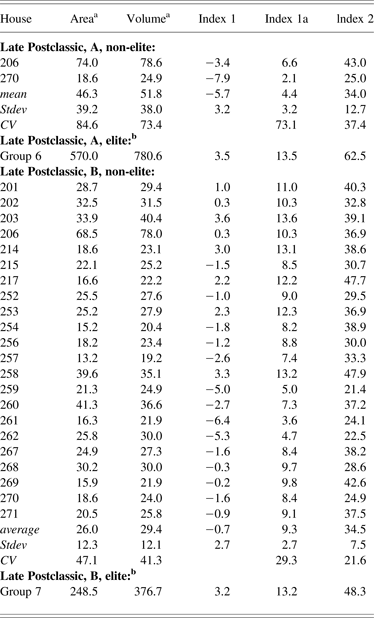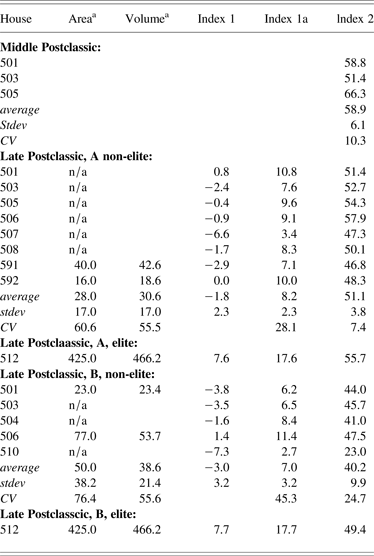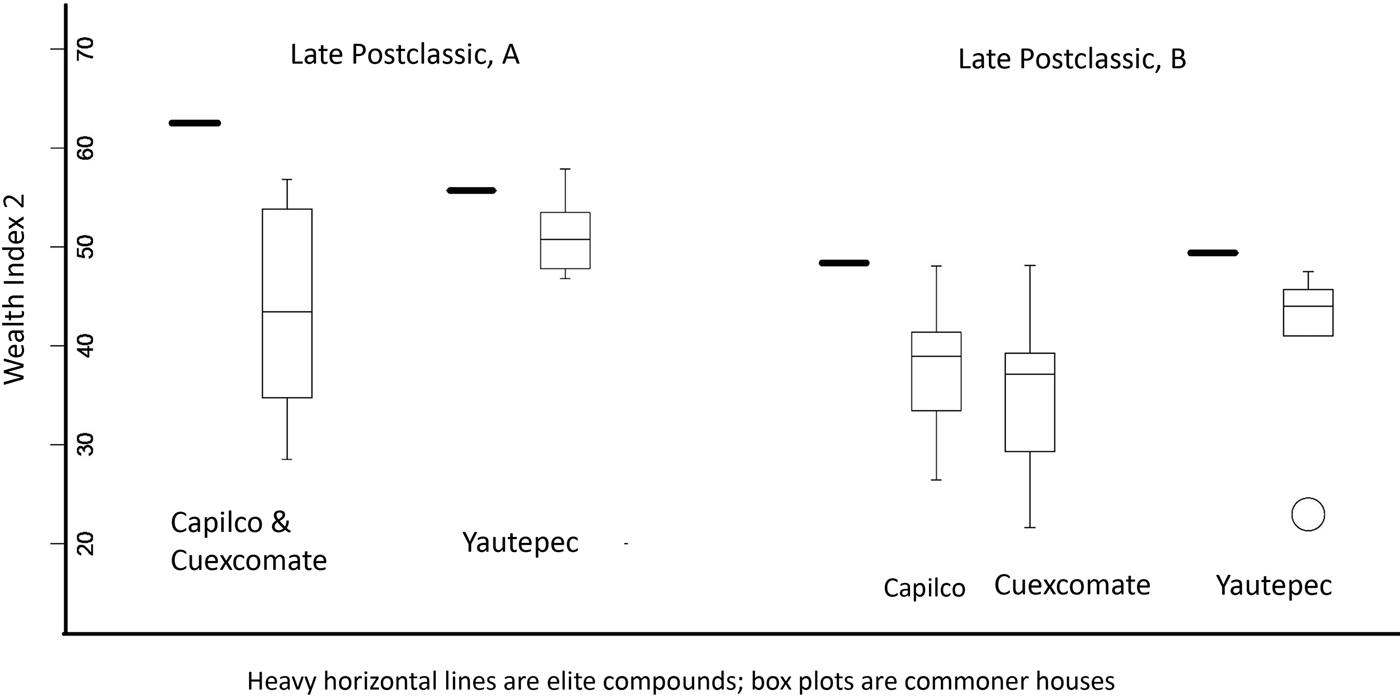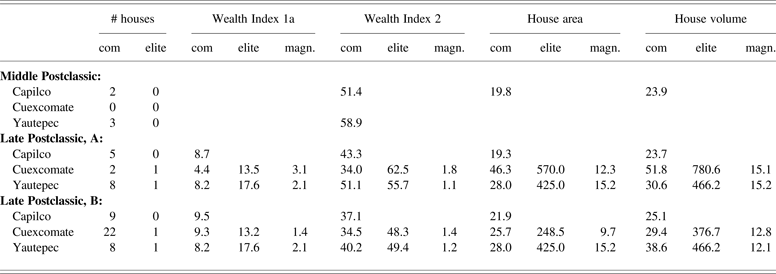INTRODUCTION
Was there a major gulf in standards of living between Aztec nobles and commoners? The luxuriant lifestyles and great wealth of kings and high nobles, as described in many ethnohistoric documents, contrast greatly with the modest economic situation of peasants and urban commoners as suggested by archaeological excavations of houses. But what about lower-ranking nobles? Were their lifestyles radically different from those of wealthy commoners, or was there more of a continuum—and perhaps an overlap between social classes—in wealth and standards of living? How important was social class in Aztec society? Most writers, basing their analyses on written sources, describe Aztec nobles and commoners as separate and distinct social classes (Berdan Reference Berdan2014; Carrasco Reference Carrasco1971; Hicks Reference Hicks, Claessen and Oosten1996; Lockhart Reference Lockhart, Lockhart and Altman1976; Nutini and Isaac Reference Nutini and Isaac2009). A social class can be defined as, “an aggregation of persons in a society who stand in a similar position with respect to some form of power, privilege, or prestige” (Lenski Reference Lenski1966:74–75). This line of Aztec class analysis posits major differences in wealth, power and status—leading to significant lifestyle differences—between nobles and commoners. Arguing against this view, Brumfiel and Robin (Reference Brumfiel, Robin, Nichols and Pool2012:674) suggest that:
Many archaeologists question whether this model of class stratification, so clearly described in the documents, accurately portrays ancient Mesoamerica or whether it constitutes a misreading of Mesoamerican society … When archaeologists have examined material remains for evidence of social inequality in ancient Mesoamerica, the seemingly clear case for the existence of two distinct classes becomes less certain.”
Although these authors do not provide citations for the “many archaeologists” or their findings, they go on to suggest that:
“when archaeologists examine the material record, the variation seems to be distributed along a continuum of quantity and quality, suggesting the existence of a continuum of social differentiation in ancient Mesoamerica rather than segmentation into discrete classes” (Brunfiel and Robin Reference Brumfiel, Robin, Nichols and Pool2012:674–675).
In a similar vein, Steere and Kowalewski (Reference Steere and Kowalewski2012:20) report surface collection data from the site of Inguiteria (Coixtlahuaca) in Oaxaca that “show a distribution broader and more continuous than would be expected if wealth were accessed strictly by noble or commoner legal status”. They go on to suggest that this pattern of continuous wealth distribution “was common in much of Mesoamerica in the Classic and Postclassic periods” (Steere and Kowalewski (Reference Steere and Kowalewski2012:20).
We suggest that these apparent contradictions can be resolved by acknowledging two types of social inequality: social class differences, and wealth variation. These two domains should be analyzed independently; the existence or social significance of class is a separate issue from the distribution of wealth in a society. In most ancient states, significant wealth differences mapped onto social class (see below), but this was not always the case. As readers of the novels of Charles Dickens are well aware, poor aristocrats and wealthy commoner merchants blurred early industrial British class distinctions in wealth, if not prestige. Wealth distributions, social class, and their relationship, are empirical domains amenable to archaeological analysis.
One of the notable regularities among early states and empires was a division into two social classes—elite and commoner. Bruce Trigger (Reference Trigger2003:145–152) reports this division as a basic feature of all early states (including the Aztecs). Furthermore, the elite class in most of his sample (all cases except Yoruba and Mesopotamia) was hereditary. Other comparative analyses of ancient systems of inequality reach similar conclusions regarding the existence of a material and social gulf between elite and commoner social classes (e.g., Bottomore Reference Bottomore1965; Brown Reference Brown1988; Lenski Reference Lenski1966; Sjoberg Reference Sjoberg1960:109–110; Smith Reference Smith and Smith1976). A group of economic historians examining comparative data on wealth inequality in preindustrial societies (Milanovic et al. Reference Milanovic, Lindert and Williamson2011; Williamson Reference Williamson2010) conclude that, “the lion's share of inequality in pre-industrial societies is and was accounted for by between-class average income differences” (Williamson Reference Williamson2010:229). We acknowledge that some agrarian state societies have additional categories that may represent classes—slaves, serfs, or middle categories—but the comparative data suggest that the existence of such categories will rarely obscure the basic elite-commoner distinction.
The issue of wealth variation and inequality independent of social class is far less explored for ancient states. Measures such as the Gini index permit quantitative comparisons of wealth inequality among sectors or states, but their application by archaeologists is still in its infancy (see Smith et al. Reference Smith, Dennehy, Kamp-Whittaker, Colon and Harkness2014). If archaeologists find that a wealth measure does not conform to a bimodal distribution expected for social classes (e.g., Steere and Kowalewski Reference Steere and Kowalewski2012), several explanations are possible: (1) social class was not important in the context studied; (2) social class was important, but the classes were not strongly distinguished by the particular kind of wealth studied; or, (3) the particular wealth markers are not adequate measures of social class differences. These alternatives may be difficult to distinguish empirically. We suggest that archaeologists need to conduct more research into the nature of social class and physical wealth—both contextually and comparatively—and they need to explore new measures to monitor these phenomena and their relationships.
In this paper we present data on residential architecture and artifacts from excavations at three Aztec-period sites in Morelos, Mexico that are particularly informative on these questions of wealth and social class. The sites are a village (Capilco), a town (Cuexcomate) and a city (Yautepec). We ask four questions:
(1) Can elite and commoner houses be distinguished architecturally? The data provide a strong positive answer to this question.
(2) Can elite and commoner households be distinguished on the basis of their domestic artifacts? This question is answered in the affirmative, but the magnitude of elite-commoner artifact differences is lower than for residential architecture.
(3) Is there significant architectural and artifactual variability among commoner households? We do find such variability, but at a low level that does not suggest the existence of additional social classes or ranked categories intermediate between elites and commoners.
(4) How do wealth levels and elite-commoner artifact differences compare among sites and across time? We generate a general wealth index that reveals complex regional and temporal patterns of class inequality within Aztec-period Morelos.
RESEARCH SETTING
The sites described in this paper were excavated by Michael Smith in the 1980s and 1990s in the Mexican state of Morelos. Chronological research involving radiocarbon dates, ceramic seriation, and stratigraphic analysis produced parallel Postclassic sequences for each site. While separate phase names are used for the two areas, we employ common period labels. The Middle Postclassic (“MPC”) period corresponds to the Early Aztec phase in the Basin of Mexico. In Morelos the dates are circa a.d. 1100–1300. This was a time of city-state formation and population growth throughout central Mexico. The period Late Postclassic, A (“LPC-A”) corresponds to the first half of the Late Postclassic, or Late Aztec periods, prior to the conquest of Morelos by the Triple Alliance or Aztec Empire. The dates are ca. a.d. 1300–1430. This was a time of expanding trade and political maneuvering by city-states. The Late Postclassic, B period (“LPC-B”) runs from ca. 1430 until one or two decades after the Spanish conquest. During this time the polities of Morelos paid taxes to the Aztec Empire, but local city-states continued to rule the area.
Capilco and Cuexcomate are located in the western part of the state of Morelos (Figure 1). These sites are notable because house foundations were visible on the ground surface prior to excavation and thus permitted the use of random sampling to select houses to excavate. Capilco—a small village in Aztec times—covers 1.1 hectare in area; it is located just east of the large Epiclassic city of Xochicalco. The larger and more architecturally complex town site of Cuexcomate covers 14.2 ha along a ridge 3 km to the east of Capilco. Nine of 22 houses at Capilco were tested or completely excavated, as were 35 of 150 houses at Cuexcomate (see Figure 2). Information about these sites may be found in Smith (Reference Smith1992, Reference Smith2015).

Figure 1. Map with site locations.

Figure 2. Maps of Cuexcomate and Capilco.
Capilco was always a small community. In the MPC the hamlet had approximately 6 houses growing to 14 in the LPC-A, and to its greatest population of 22 domestic structures in the LPC-B. Cuexcomate was not founded until the LPC-A. During this period an estimated 43 houses were established at Cuexcomate where they were distributed in three clusters: a) 33 houses at the north end of the site; b) a public plaza area in the center of the site bordered by a massive elite compound (Group 6), a temple platform, and some other structures; and, c) a small group of about 6 houses at the east end of the site. In the LPC-B period, Cuexcomate underwent a tripling of population to approximately 146 houses situated continuously along a 1 km ridge. The Group 6 compound was abandoned by this time, but all other houses continued in use and a new smaller elite compound (Group 7) was built along the north edge of the public plaza.
The archaeological site of Yautepec, located under the modern town of the same name, is located in north-central Morelos (Figure 1). The site covers approximately 210 ha (Figure 3). Yautepec was capital of a local city-state and also an over-capital for several other city-states in the region (Information can be found in Smith [Reference Smith2016b]; Smith et al. [Reference Smith, Heath-Smith, Kohler, Odess, Spanogle and Sullivan1994]; and Smith et al. [1999]).

Figure 3. Map of Yautepec.
The center of the modern town of Yautepec lies to the north of the center of the ancient Aztec city, and modern occupation around the core of the Aztec settlement is not dense. In 1993, Smith's project located and excavated seven house structures with associated middens and an additional seven dense domestic midden deposits not clearly associated with any particular architectural structures, and twenty burials. Houses were located through a combination of surface inspections, intensive test-pitting operations, and information from residents of Yautepec. Archaeologists from the Centro Instituto Nacional de Antropología e Historia Morelos excavated part of a large Aztec royal palace in the modern town of Yautepec (de Vega Nova Reference de Vega Nova1996; de Vega Nova and Mayer Guala Reference de Vega Nova and Guala1991). Figure 4 shows the chronological placement of the ceramic phases at these sites.

Figure 4. Archaeological chronology of the excavated sites.
BACKGROUND: ARCHITECTURE, ARTIFACTS, AND WEALTH
Our conceptual approach begins with the claim that the wealth and prestige of households in agrarian states influence both the size and form of houses, and the nature of domestic artifacts. This claim is based on comparative data reviewed elsewhere (Ames Reference Ames, Alexander Bentley, Maschner and Chippindale2008; Blanton Reference Blanton1994; Smith Reference Smith1987). We further argue that the size of houses is likely to be a stronger and more consistent predictor of household wealth than are measures based on domestic artifacts (although these two types of remains track household wealth at different stages in a household's developmental trajectory). First we review the comparative and theoretical evidence in support of these claims. Then we examine house size at our three sites and report two discrete size categories that we interpret as elite and commoner residences. We then test whether these categories can be distinguished on the basis of their domestic artifacts alone. While their artifacts inventories are statistically distinguishable, the magnitude of elite-commoner differences is smaller than their differences in house size.
Two complementary conceptual approaches, both grounded in consumption theory (Douglas and Isherwood Reference Douglas and Isherwood1996; Orlove and Rutz Reference Orlove, Rutz, Orlove and Rutz1989), predict that wealthier households will have larger houses. The energetic approach predicts that wealthier and/or more powerful households will typically invest greater resources (labor and materials) in constructing their house than will poorer households (Abrams Reference Abrams and Schiffer1989; Bodley Reference Bodley2003:97). The greater resource investment often produces larger houses. The architectural communication approach predicts that individuals and households vary the attributes of their houses in order to send public messages to other people (Smith Reference Smith2011). Amos Rapoport (Reference Rapoport and Poyatos1988) calls these messages “middle-level meaning,” and notes that they typically concern identity, status, wealth, power, or cultural values. Richard Blanton (Reference Blanton1994) uses the term “indexical communication” for such messages, and he analyzes variation in their expression within and among peasant traditions.
Houses and Wealth
Following predictions of both the energetic and architectural communication theories, elites in most agrarian states have houses that are both larger and more elaborate than commoner houses. Roman housing provides perhaps the clearest evidence; wealthy houses and villas stand out from commoner or vernacular housing in their size, construction materials, and aesthetic elaboration (Bowes Reference Bowes2010; Ellis Reference Ellis2000; Nevett Reference Nevett2010; Wallace-Hadrill Reference Wallace-Hadrill1994). In precolonial Bali, the average noble's house was five times as large as the average commoner's house, and the king's palace was 60 times as large as commoner houses (Bodley Reference Bodley2003:97). While many additional cases could be cited, there are very little systematic comparative data on this topic, perhaps because elite-commoner house differences seem obvious and not at all surprising.
Far more data are available on the continuous variation of house size in relation to wealth, primarily from contemporary peasant societies. We mention only a few examples to illustrate the relationship; this topic is also in need of systematic comparative analysis. For the highland Maya village of Panajachel, Tax (Reference Tax1953:Table 82) presents data on house size and wealth; household wealth is positively correlated with both interior house area (r2 of 0.62) and with the mean interior space per adult (0.73). Ethnographers have reported this positive association between house size and wealth in peasant villages around the world, from Mesoamerica (Wilk Reference Wilk1983) to China (Yang Reference Yang1945); see also Blanton (Reference Blanton1994) and Castro et al. (Reference Castro, Hakansson and Brokensha1981).
On the other hand, “building size does not necessarily indicate family wealth. Instead, it may more accurately reflect household size” (Cutting Reference Cutting2006:239); see also Kramer (Reference Kramer1982:69–70) or Netting (Reference Netting1982). Kathryn Kamp (Reference Kamp1987:288) presents a useful discussion of the conditions under which house size (or compound size) does or does not correlate with wealth in a modern Syrian village.
We draw several archaeological implications from the comparative data. First, the existence of major quantitative and qualitative distinctions between a small number of large, elaborate houses, and a much larger group of smaller houses points to the presence of elite and commoner social classes. Such an inference is strong to the extent that there are independent data for the existence of social classes in the society in question. Second, archaeologists cannot simply assume that relatively minor variations in house size reflect wealth differences among households without additional tests. Such tests could involve the association of wealth-related differences in domestic artifacts with the house size variation. Third, archaeologists should exercise caution in reasoning from a lack of very large and elaborate residences to the lack of strong class divisions. Unless an archaeologist has a relatively complete sample of the houses from a particular spatial unit, such inferences may be unwarranted.
Domestic Artifacts and Wealth
In an earlier paper, Smith (Reference Smith1987) outlined conceptual and methodological issues in using domestic artifacts to measure wealth archaeologically, and these findings have not been superseded. He established a comparative basis for the relationship between household wealth and artifacts using ethnographic and historical cases. For example, a series of Guttman scales of household possessions in rural contexts in Tahiti, Mexico, and Finland support the notion that such objects reflect wealth in a systematic fashion, as do quantitative inventories from Mexico. Research on depression-era Oklahoma farm families furnishes further quantitative support for this idea, and a thorough study of physical household wealth in the U.S. colonies in 1774 (Jones Reference Jones1980) extends the time frame into the more distant past.
Smith (Reference Smith1987) reviewed the sensitivity of various functional classes of domestic possessions to household wealth, in relation to their archaeological visibility and usefulness. The best category—for both social class differences and variation within the commoner and elite classes—is ceramic serving ware. Other categories of goods that reflect wealth are much less useful for archaeologists (e.g., clothing or furniture), whereas the strong archaeological presence of common categories like cooking utensils is offset by their lower sensitivity to wealth variation (For more recent studies of household artifacts and wealth, see Costin and Earle [Reference Costin and Earle1989]; Menzel [Reference Menzel1994]; Morris [Reference Morris, Manning and Morris2005]; Olson [2001]; Voss [Reference Voss2012]; and Smith [Reference Smith2016a].
Architecture versus Artifacts as Wealth Indicators
We suggest that in general, the size and elaboration of domestic architecture should be a stronger indicator of household wealth than domestic artifact inventories. Although there are some theoretical reasons and evidence to support this claim, the empirical data from premodern settings are quite thin. In modern communities, economists consider house value the strongest material indicator of household wealth, largely because of the high cost of houses (Forrest and Murie Reference Forrest and Murie1995). Jones (Reference Jones1980) documented the same situation in the American colonies in 1774. Of the total mean value of household physical wealth, the house and land comprised 55%, as compared to only 7% for consumers' durable goods (i.e., household possessions). While both categories are strongly correlated with total household wealth, a far greater proportion of household wealth was taken up by the house, making it a much stronger predictor of total wealth. Clark (Reference Clark2002) provides parallel data for early modern England.
The direct comparison of houses and artifacts as wealth markers, however, ignores a basic temporal distinction in the ways they mark wealth. Houses are constructed at a given point in time and they may last for many generations. During that time, the wealth of the residents may fluctuate. Even when architectural additions and modifications can be identified by archaeologists, thereby increasing the temporal resolution, the economic fortunes of successive households may diverge from the conditions under which a house was initially built or enlarged. Compared to architecture, domestic artifacts are far more sensitive to shorter-term fluctuations in wealth and other domestic conditions (Lewis Reference Lewis, Lathrap and Douglas1973; Smith Reference Smith1987; Wilson Reference Wilson1994).
RESIDENTIAL ARCHITECTURE AND INEQUALITY IN MORELOS
Our first question concerns the relationship between residential architecture and wealth inequality:
Can elite and commoner houses be distinguished architecturally?
Houses at Capilco, Cuexcomate and Yautepec exhibit variability in their size, materials, workmanship, and design features. We discuss this variation with respect to the energetic and communication dimensions of inequality as discussed above. We describe major differences between two categories of house at these sites, and we associate these categories with the commoner and elite social classes. The association of archaeological house size categories with Aztec social classes was first established for Capilco and Cuexcomate by Smith (Reference Smith1992). In this section, we refine that analysis and add data from Yautepec to produce broader conclusions.
Commoner Houses
Commoner houses in Aztec-period Morelos are small structures that correspond to one of two architectural categories defined in Smith (Reference Smith1992): ground-level houses, and houses on low platforms (called Type B platform houses). Ground-level houses are “rectangular structures that were constructed at the level of the ground with stone wall foundations” (Smith Reference Smith1992:293). The vast majority of commoner houses correspond to this category. They are small structures (see below), often part of patio groups (several houses built around a common patio). As shown in Smith (Reference Smith1992:327–355), there is strong evidence that Morelos patio groups contained multiple households, one per house structure. Type B platform houses are “small structures buildt on discrete low platforms” (Smith Reference Smith1992: 319). Except for a single house compound at Cuexcomate (Group 7), all Type B platform houses at these sites are either situated as isolated houses, or as parts of patio group in which the other houses are ground-level houses. For reasons discussed below, Smith classifies Group 7 as an elite residence.
At Cuexcomate and Capilco, the mean interior area of 46 excavated ground-level houses is 14 square meters (Smith Reference Smith1992:297), and the six ground-level houses at Yautepec have a mean area of 26 square meters (Smith et al. Reference Smith, Heath-Smith and Montiel1999). Foundation walls at all sites consist of double rows of stone cobbles. At Cuexcomate and Capilco most houses had floors of stone cobbles covered with sand (crushed tepetate), whereas lime plaster floors were more common at Yautepec. The house walls were constructed of adobe bricks. Figure 5 shows some examples of ground-level houses from Cuexcomate and Capilco. These structures are quite similar to the traditional adobe houses still built in rural Morelos today (Smith et al. Reference Smith, Sterpone, Heath-Smith and Smith1992). They are relatively easy to build as the materials are readily available in the vicinity of the sites, and labor input is low.

Figure 5. Plans of a sample of ground-level houses at Cuexcomate and Capilco.
Type B platform houses are located at Cuexcomate and Yautepec. At the former site, four are situated in Group 7, an elite compound, and six others are distributed throughout the site. There are two houses of this type at Yautepec (units 501 and 503, structure 2). The mean top surface area for the Cuexcomate examples is 36 square meters. If these low platforms supported adobe houses with some exterior space, then the mean size of the adobe dwellings would be close to that of ground-level houses.
Elite Residences
There are two elite residences at Cuexcomate and one at Yautepec (not counting the royal palace). Our definition of this category is based on the following attributes:
1. Size. These structures are larger than commoner houses by an order of magnitude.
2. Complexity. They show evidence for occupation by many people, most likely multiple family units.
3. Platforms. They are built on platforms elevated above the surface of the ground.
4. Construction material. They use construction materials and methods of higher quality of value than commoner houses. These include lime plaster on floors and walls, and ample use of dressed stones.
This definition allows a range of variation in the size and layout of elite residences (Figure 6). Group 6 at Cuexcomate was occupied in the LPC-A period. It consists of a series of connected platforms (0.6 m in height) arranged around a central patio with a single entrance. The platforms have rooms and exterior areas, plus a raised platform on the west side. This compound is located on the west side of the single public plaza at Cuexcomate, opposite a temple. In the LPC-B period Group 6 was abandoned and Group 7 built along the north size of the plaza. This latter group consists of several Type B platform houses arranged around two patio areas that face the plaza to the south. The platforms, all of which were occupied in the LPC-B period only, clearly constitute a single compound. In the case of these two compounds, their location on the central public plaza at Cuexcomate is another reason they were identified as elite residences.

Figure 6. Elite residential compounds: (a) Group 6, Cuexcomate; (b) Group 7, Cuexcomate; (c) Structure 6, Yautepec.
Structure 6 at Yautepec (Figure 6, C) was partially excavated by the Albany Yautepec project, and then the remaining preserved architecture was cleared off by archaeologists from the Centro Instituto Nacional de Antroplogía e Historia Morelos (Rosas Sánchez Reference Rosas Sánchez1996). The entire structure sits on a low platform, ca. 50 cm in height. The quality of construction materials in structure 6 stands out as radically different from the commoner houses at Yautepec.
Architectural Variation and Inequality
Our discussion of size variation employs calculations of architectural volume. The data for Capilco and Cuexcomate were initially published in the site report (Smith Reference Smith1992:259–363). For ground-level houses volume was calculated from the length and thickness of the walls (as measured from the stone foundations) and a standard wall height. For platform structures, the volume of platform fill was added to the volume of any structures preserved or inferred on top of the platforms. In 2014 all calculations were checked, and for the two elite compounds (Groups 6 and 7), the volumes of the component platforms were summed to get the total volume for the compound. This is a modification of Smith's (Reference Smith1992) prior presentation of house size data, where the individual sides of the Group 6 elite compound were graphed as separate structures. Portrayal of the compound as a single residence conforms more closely to our goal of comparing households, since the entire compound was almost certainly the residence of a single elite household with multiple nuclear family units. This pattern was described for an early colonial elite compound in Yautepec in a Nahuatl-language census published by Carrasco (Reference Carrasco1972).
The architectural volume data are portrayed in figures 7 and 8. The extreme size differentiation of elite and commoner residences at Cuexcomate and Capilco conforms to the expectations of the energetic approach to architecture and inequality. These categories are also distinguished by visual attributes as predicted by architectural communication models. The size difference itself is a visual signal of the categorical distinction between social classes; as noted by physicist Philip W. Anderson (Reference Anderson1972), “More is different.” The elevation of elite residences on platforms contrasts with the ground-level entrances of most commoner residences. The use of height as an element of middle-level architectural communication to signal importance is widespread among the cultures of the world (Rapoport Reference Rapoport1990:107). Groups 6 and 7 also differ from commoner houses in their far greater use of superior building materials such as lime mortar and plaster, and cut stones.

Figure 7. Distribution of house size (architectural volume) at Capilco and Cuexcomate.

Figure 8. Distribution of house size (architectural volume) at Yautepec.
At Yautepec, far fewer houses were excavated, and only one patio group was documented. Figure 8 presents volumes of the Yautepec structures, calculated using the same method that had been applied to Capilco and Cuexcomate. The basic pattern is similar to Cuexcomate in the LPC-A period: the elite compound (Structure 6, or unit 512) stands out as much larger than the other houses. This graph does not include the royal palace, whose size (6,175 square meters; 17,221.5 cubic meters volume) is another order of magnitude larger than Structure 6. In the dimension of architectural communication, Structure 6 differs from commoner houses at Yautepec in similar ways to the elite compounds at Cuexcomate. Its platform, however, is lower than Group 6 at Cuexcomate.
When continuous variation is considered, independent of elite-commoner differences, the data in Figures 7 and 8 point to moderate levels of variability in the sizes of commoner houses. The coefficients of variability are on the order of 40 to 50 (see Tables 3–5 below). But these are all small, one-room houses. At Cuexcomate and Capilco, only one commoner house is larger than 40 m2, and at Yautepec, a single house is larger than 70 m2. In sum, these data support the notion that class differences can be identified from the size of residential structures.
SITE-SPECIFIC ARTIFACTUAL MARKERS OF WEALTH: WEALTH INDEX 1
Our second question is:
Can elite and commoner households be distinguished on the basis of their domestic artifacts?
This question follows from a positive answer to the first question about architectural markers of social class. Our first method for using domestic artifacts to measure wealth takes advantage of the architectural variation discussed above. Based on the assumption that the size differences marked the distinction between elite and commoner houses, we used various methods to identify an artifact measure to best distinguish the two categories. We call the calculated measure “wealth index 1.” Wealth index 1 was calculated separately for four contexts: (1) Cuexcomate and Capilco in the LPC-A period; (2) Cuexcomate and Capilco in the LPC-B period; (3) Yautepec in the LPC-A period; and (4) Yautepec in the LPC-B period.
Wealth index 1 was designed to distinguish elite and commoner domestic artifact inventories in these four contexts. One drawback is that the formula is different in each of these contexts. This means that the values for wealth index 1 are not directly comparable, making it difficult to examine change over time or differences between sites. Wealth index 2, discussed below, was then created to rectify this shortcoming.
Calculating Wealth Index 1 at Cuexcomate and Capilco
We first applied discriminant function analysis (Tatsuoka Reference Tatsuoka1970) to determine whether the frequencies of ceramic and lithic types at each house could distinguish between three architecturally identified social groups; Capilco non-elite, Cuexcomate non-elite, and Cuexcomate elite. This was calculated separately for the LPC-A and LPC-B periods. The results clearly showed that houses could be distinguished by portable artifacts. In fact, the analysis classified all of the house middens into their correct architectural group, except one LPC-B house at Cuexcomate, which was switched from non-elite to elite in the analysis. This analysis showed that artifacts can indeed distinguish elite and commoner domestic remains at these sites.
Unfortunately, in discriminant analysis the number of variables is limited by the number of cases. This meant that only eight of the 28 variables were included in the analysis in the LPC-A and eleven variables in the LPC-B. To examine the relationships of all variables to the architectural groups, we turned to analysis of variance (ANOVA) and difference of means tests to distinguish between the elite and non-elite groups. The ANOVA values and means tests identified those variables that most strongly marked the differences between architecturally defined elite compounds at Cuexcomate and other non-elite houses (see Table 1).
Table 1. ANOVA of household artifacts at Capilco and Cuexcomate

a *indicates insignificant F value at the 0.2 level.
b Variable used to calculate wealth index 1.
S strong.
W weak.
+ positive.
− weak.
Values in parenthesis have higher scores for non-elite contexts.
The ANOVA results show that while many types of serving wares are associated with wealth, cooking wares are less related. Serving wares have both energetic and symbolic values because decorated wares are costly to produce and because of the prestige associated in owning more costly items (Douglas and Isherwood Reference Douglas and Isherwood1996). Imports are also associated with wealth primarily due to their greater costs of manufacture, transportation and marketing. Textile spinning items though are more associated with non-elites in the LPC-B period.
From the means tests and the ANOVA calculations, we chose the five most sensitive variables for each phase to develop a wealth index. For each phase, we selected the four variables with the greatest F value (Table 1), plus Aztec III Black-on-Orange. Although the latter type did not distinguish the contexts in this sample as consistently as the other variables, Smith judged that this was likely a good wealth indicator, based on its presence and frequencies in contexts not included in the sample analyzed in Table 1. For LPC-A, the other four variables included are Morelos imports, total bowls, other decorated bowls, and red bowls. In the LPC-B the variables used in addition to Aztec III bowls are total bowls, red bowls, Tlahuica Polychrome bowls, and long-handled censers.
Percentages of the variables were transformed into z-scores on a per phase and per site basis and then summed to provide each house unit with a value called wealth index 1, as seen in Tables 3 and 4. A score of zero for a house suggests an “average” wealth level, positive values indicate above-average wealth, and negative values represent below-average wealth. To compare wealth index 1, we have added a constant of 10 to all values at all sites so that negative numbers will be eliminated; this adjusted index is called wealth index 1a.
Calculating Wealth Index 1 at Yautepec
Because of the smaller sample of houses to work with, discriminant function analysis and ANOVA tests are not suitable for the Yautepec analysis. In their place we examined differences of means using t-tests. We first examined whether the data had a normal population. Given the small sample size, we expected some of the variables to be less normal than others. We examined box and plot diagrams for every variable in each time period and found that two LPC-A units consistently were identified as outliers. When we removed them from the analysis, the population was more normally distributed and we continued with a variety of statistical procedures. These outliers were later assigned wealth index 1 values based on the variables chosen from the analysis. The t-test identified variables with the strongest positive and negative associations to the elite assemblage. As shown in Table 2, the variables with the greatest differentials for the LPC-A period were basins, decorated local bowls, total decorated bowls, Tlahuica polychrome bowls, and C1 polychrome ceramics. In the LPC-B, the relevant categories were basins, plain jars, braziers, total kitchen vessels, and B7 polychrome bowls.
Table 2. ANOVA of household artifacts at Yautepec

a *indicates insignificant t value at the 0.2 level.
b Variable used to calculate wealth index 1.
S strong.
W weak.
+ positive.
− weak.
Values in parenthesis have higher scores for non-elite contexts.
To gain a better understanding of the groupings, we performed a non-hierarchical cluster analyses (k-means) to see whether the middens without architecture more closely resembled the commoner or elite houses. Although the simplest, 2-cluster, solution did not completely separate the elite and commoner middens, a k = 3 solution did isolate the elite house from all others. The results of the k-means clustering indicated that the non-architectural excavation units had assemblages more similar to the non-elite units than to the elite class in both time periods. Therefore, we identified all units without corresponding architecture as non-elite middens. Frequencies of the variables were standardized to z-scores for the statistical analysis, as at Capilco and Cuexcomate.
Interpretations of Wealth Index 1
The scores on Wealth Index 1 are listed in Tables 3–5, and the elite-commoner differences are illustrated with box plots in Figure 9. At both Cuexcomate and Yautepec, the elite and commoner architectural categories are clearly distinguishable on the basis of their artifacts alone. There is considerable variation among households within the commoner class, and a few commoner households have wealth index values higher than their local elite household. There is only one likely candidate for a residence whose wealth and social standing may have been intermediate between the elite and commoner categories: Unit 506 at Yautepec in the LPC-B period. This structure is much larger than other commoner houses at Yautepec, both in area and construction volume, and its value on Wealth Index 1a is more than one standard deviation above the commoner mean. In the discussion section below we suggest a possible social interpretation of this structure.

Figure 9. Box plots of wealth index 1a, showing differences between elite compounds (heavy horizontal line) and commoner houses (box plots). Commoner houses at Capilco and Cuexcomate are lumped for the LPC-A period (due to sample size), but separate for the LPC-B period.
Table 3. House size and Wealth indices at Capilco

a Area in square meters and volume in cubic meters.
b Wealth values are the mean of individual structure values.
Table 4. House size and Wealth indices at Cuexcomate

a Area in square meters and volume in cubic meters.
b Wealth values are the mean of individual structure values.
Table 5. House size and Wealth indices at Yautepec

a Area in square meters and volume in cubic meters.
b Wealth values are the mean of individual structure values.
GENERALIZABLE CERAMIC MARKERS OF WEALTH: WEALTH INDEX 2
Wealth index 1 is dependent on the particular quantitative distributions of artifact types in each phase at each site. It is calculated separately for each setting as the combination of ceramic variables that most strongly distinguish between elite and commoner households as identified from architecture. Therefore it cannot be directly compared across sites or through time, and a more general index is needed. We use a wealth index suggested by Smith (Reference Smith1987), wealth index 2, This measure is defined as the sum of the frequencies of local decorated ceramic types and two times the frequencies of imported ceramic types. Decorated and imported ceramics in most economies are more expensive to own than plain vessels, and they may also have symbolic value that contributes to their ability to distinguish wealth levels. Wealth index 2 was initially devised for two reasons: (1) it seemed sensitive to the kinds of wealth variation expected in Aztec provincial societies; and (2) it was easy to calculate and did not rely upon specific ceramic typologies that typically differ among regions and settings.
Garraty (Reference Garraty2000) calculated a number of similar wealth indices for Aztec ceramics in the Teotihuacan Valley. He found that several were highly correlated with one another, which he interprets as supporting their interpretation as measures of “eliteness.” He does not provide an external test of these measures, however. We evaluate our wealth index 2 by comparing it to the architectural categories that we have interpreted as social class categories.
Tables 3–5 contains the data for Wealth Index 2, and Figure 10 uses box plots to illustrate the elite-commoner differences. These quantitative patterns parallel those found for Wealth Index 1a, although the magnitudes of the elite-commoner differences are weaker. This is not surprising, since Wealth Index 1 was designed to maximize elite-commoner distinctions. But even the more generic Wealth Index 2 can distinguish between elite and commoner contexts. We calculated correlation coefficients (Pearson's r) between the two wealth indices for our contexts, and five of the six values are strong and significant (Cuexcomate and Capilco combined, LPC-A:.90; Capilco, LPC-B:.74; Cuexcomate, LPC-B:.78; Yautepec, LPC-A:.57; Yautepec, LPC-B:.73). These values offer additional support for the ability of these indices to monitor wealth at the excavated sites.

Figure 10. Box plots of wealth index 2, showing differences between elite compounds (heavy horizontal line) and commoner houses (box plots). Commoner houses at Capilco and Cuexcomate are lumped for the LPC-A period (due to sample size), but separate for the LPC-B period.
DISCUSSION
Substantive Findings
Our third question is:
Is there significant architectural and artifactual variability among commoner households?
The commoner houses at Capilco, Cuexcomate, and Yautepec are far from uniform in the various architectural and artifactual measures of wealth (Tables 3–5). The coefficient of variation for commoner housing volume is quite low at Capilco in each phase (12.7 and 13.2 for the phases with more than two measured houses), larger at Cuexcomate in the LPC-B (41.3), and highest at Yautepec (55), although the latter site has only two measured houses in each phase. The corresponding measures for the wealth indices do not follow the same pattern, however (17.2 to 27.9 for Capilco; 21.6 for Cuexcomate, and 7.4 and 24.7 for Yautepec). This suggests that variation in commoner house size and variation in commoner wealth index may not be strongly associated at these sites.
To explore whether the variation in house size matched variation in the wealth indices with more precision, we calculated correlation coefficients (Pearson's r) between architectural volume and each of the two wealth indices for commoner houses. We calculated these for each of three contexts (Cuexcomate and Capilco together for LPC-A; and these sites separately for LPC-B). The correlations are all small and not significant (there are insufficient volume measurements at Yautepec to calculate correlations).
The lack of correlation between house size (volume) and the wealth indices for commoner houses suggests that these measures may be out of step temporally for commoner households. If houses do indeed signal wealth at the time of their construction, while artifacts measure wealth on a shorter time scale, then we have no independent evidence against which we can test the latter process. Indeed, the fact that the relevant ceramic phases are many decades long means that a series or sequence of short-term household wealth levels may be compressed or conflated in the middens we have analyzed.
As suggested in our discussion of Wealth Index 1 above, there is one possible candidate for a residence whose wealth and social standing may have been intermediate between the elite and commoner categories: Unit 506 at Yautepec in the LPC-B period. This structure stands out from other commoner houses (at all sites) in its area and volume, and its values on the two wealth indices are the highest of the Yautepec commoner houses. We suggest that this house may have been the residence of the household of an official described in various written sources as a calpolli head.
A calpolli named Molotla, included in an early Colonial census report (Hinz et al. Reference Hinz, Hartau and Heimann-Koenen1983), was part of the city of Yautepec at the time of the Spanish conquest (Carrasco Reference Carrasco, Nutini, Carrasco and Taggert1976; Hinz Reference Hinz, Illius and Laubscher1990). Aztec calpollis had commoner officials with various duties, which included tax collection and record keeping (Durán Reference Durán and Garibay Kintana1967:2:182; Lockhart Reference Lockhart1992:17). Related census accounts from the western Morelos communities of Huitzillan and Quauhchichinollan indicate that calpolli heads were wealthier than other commoners, as determined by the sizes of their fields and their tax or rent obligations (Smith et al. Reference Smith, Dennehy, Kamp-Whittaker, Colon and Harkness2014). Demographic reconstruction suggests that Yautepec had some eleven calpolli. Other than this one large commoner-style house, no other excavated structures at these sites stand out in their architecture or artifacts as likely candidates for an intermediate category between commoners and elites.
Our fourth question is:
How do wealth levels and elite-commoner artifact differences compare among sites and across time?
The Middle Postclassic period was a time of colonization in Morelos and central Mexico. Interregional relations increased through alliances, and trade thrived in an expanding economy. The tax demands likely were not high. The initial commoner households at Capilco and Yautepec not surprisingly had high values of wealth index 2 (Table 6). Decorated ceramics were abundant, as were imports from other parts of Morelos. While Smith's excavations did not recover evidence for elites at these sites, it is likely that kings and elites were present at a number of Middle Postclassic city-states in Morelos (Smith Reference Smith2008).
Table 6. Means of wealth variables by site and phase

NOTE: magn is the magnitude of the elite-commoner difference; it is the elite value divided by the commoner value.
In the LPC-A period, populations grew and city-states expanded. It is probable that taxes in rural areas were increased by the kings of growing city-states, and if so, this may have contributed to a decline in the standard of living of commoners; as measured by the lower values for wealth index 2 in the LPC-A (Smith and Heath-Smith Reference Smith, Heath-Smith, Hodge and Smith1994). The architecture and artifacts of the LPC-A period indicate that elites were created or arrived at this time, along with complex social, economic and political structures at Yautepec and the newly established town of Cuexcomate. Commoners at Cuexcomate had lower wealth values than those at Capilco (Table 6). Changes also occurred in the urban center of Yautepec where wealth index 2 suggests that commoners were better off than their rural counterparts. This difference is likely due to better access to imports and valuable goods at the urban center. Elite-commoner differences in wealth index 2 were greater at Cuexcomate than at Yautepec. It may be significant here that the elite in Group 6 at Cuexcomate were the highest level of elite in that community, whereas the elites in unit 512 at Yautepec represent an intermediate level of nobility, far below the royal family who resided in the royal palace. Unfortunately, the development of wealth indices for the Yautepec royal palace is not possible.
During the LPC-B period Morelos entered into the Triple Alliance empire through conquest, and regular tax payments to Tenochtitlan were instituted. Wealth index 2 declined markedly for all categories except commoners at Cuexcomate (Table 6). A sharp decline for the Cuexcomate elite group matches the transition from a large unified platform compound to a smaller and more modest elite compound. The architectural and artifactual data for the LPC-B period point to a reduction in elite-commoner differences at Cuexcomate, but not at Yautepec. While separation of classes in this period continues, a few commoner households do have wealth values higher than the lowest elite value (Figures 9, 10).
Methodological Implications
Architecture and artifacts each can aid in distinguishing social classes and measuring wealth. In line with theoretical and comparative predictions, house size at these sites is a stronger measure of wealth than portable artifacts. The coefficient of variation for house size is consistently larger than for artifact measures. The energetic inputs for building a large structure are greater (materials and labor), and the use of platforms and fine building materials signal greater visual impact for the elite houses. One element of note is that the large sample size of houses allowed us the opportunity to categorize house sizes into groups. These groups showed a substantial gap between them, suggesting two classes. Our research also shows that when a midden is found without architecture it is possible to identify whether a midden is likely commoner or elite.
Naturally, within these distinguishable groups there are variations. To explore this variation we chose to look at the portable artifacts found in house middens. While Cuexcomate and Capilco have a house for each midden, Yautepec does not. Our analysis of Yautepec middens without houses places them firmly within the range of middens associated with commoner houses, and we feel confident in classifying these middens as pertaining to the commoner class. Variation among households in specific artifacts also permits inferences about the activities of individual households, although there is not space to explore that topic here (see Olson Reference Olson2001). Not surprisingly, we found that the context-specific wealth index (1) does a better job of distinguishing elite from commoners than the more generic wealth index (2).
Although archaeologists have long debated the nature of wealth and social class in Mesoamerica, the number of studies that apply explicit models to quantitative data remains small (e.g., Carmean Reference Carmean1991; González Licón Reference González Licón, Manzanilla and Chapdelaine2009; Hirth Reference Hirth, Santley and Hirth1993; Pugh Reference Pugh2004). Our study contributes to this body of work, in the hope that ancient Mesoamerica will someday yield sufficient quantitative economic data to reconstruct the kinds of broad patterns of social and economic change documented archaeologically in other parts of the ancient world.
RESUMEN
Analizamos la arquitectura residencial y los artefactos domésticos como expresiones de la riqueza, el prestigio y la clase social en tres asentamientos aztecas-período en Morelos, México: Capilco, Cuexcomate y Yautepec. Tamaño de la casa, tal como se expresa tanto en superficie y el volumen de la construcción, muestra una distribución bimodal firmemente que nosotros interpretamos como marca de residencias de la élite y los plebeyos. Ponemos a prueba esta interpretación con dos índices de artefactos de riqueza de los hogares. Uno está diseñado para maximizar la distinción entre los contextos elites y los contextos comuneros, pero no es directamente comparable entre contextos. El otro es un índice de riqueza genérica simple que se puede comparar entre los sitios y en diversos periodos. También analizamos la variabilidad dentro de la clase plebeya en tamaño de la casa y los inventarios de artefactos. Aunque cierto grado de variación está presente, el grado de variación es menor en comparación con el nivel de diferencias de élite-comunes.
ACKNOWLEDGMENTS
Smith directed the excavations at Capilco, Cuexcomate, and Yautepec and contributed to the analyses descried here and to the writing of the paper. Olson classified and measured the artifacts for the wealth analyses presented in this paper, and contributed to writing the paper. We would like to thank our funding agencies: the Social Science and Humanities Research Council of Canada and the National Science Foundation. We also thank the Instituto Nacional de Antropología e Historia for permits and support during the fieldwork and artifact analyses. Timothy Dennehy and April Kamp-Whittaker helped re-compile the house size data, and Angela Huster and Juliana Novic provided useful comments on an earlier draft.


